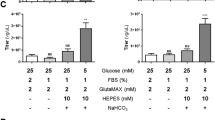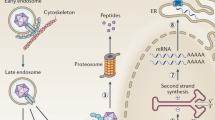Abstract
Many applications for human gene therapy would be facilitated by high levels and long duration of physiologic gene expression. Adenoviral vectors are frequently used for gene transfer because of their high cellular transduction efficiency in vitro and in vivo. Expression of viral proteins and the low capacity for foreign DNA limits the clinical application of first- and second-generation ade-noviral vectors1–7. Adenoviral vectors with all viral coding sequences deleted8–15 offer the prospect of decreased host immune responses to viral proteins, decreased cellular toxicity of viral proteins and increased capacity to accommodate large regulatory DNA regions. Currently most vectors used in vivo for preclinical and clinical studies express cDNAs under the control of heterologous eukaryotic or viral promoters. Using an adenoviral vector with all viral coding sequences deleted and containing the complete human α1-antitrypsin (PI) locus, we observed tissue-specific transcriptional regulation in cell culture and in vivo; intravenous injection in mice resulted in high levels of very stable expression for more than ten months and decreased acute and chronic toxicity. These results indicate significant advantages of regulated gene expression using genomic DNA for gene transfer and of adenoviral gene transfer vectors devoid of all viral coding sequences.
This is a preview of subscription content, access via your institution
Access options
Subscribe to this journal
Receive 12 print issues and online access
$209.00 per year
only $17.42 per issue
Buy this article
- Purchase on Springer Link
- Instant access to full article PDF
Prices may be subject to local taxes which are calculated during checkout
Similar content being viewed by others
References
Stratford-Perricaudet, L.D., Levrero, M., Chasse, J.-F., Perricaudet, M. & Briand, P. Evaluation of the transfer and expression in mice of an enzyme-encoding gene using a human adenovirus vector. Hum. Gene Ther. 1, 241–256 (1990).
Yang, Y. et al. Cellular immunity to viral antigens limits E1-deleted adenoviruses for gene therapy. Proc. Natl. Acad. Sci. USA 91, 4407–4411 (1994).
Armentano, D. et al. Characterization of an adenovirus gene transfer vector containing an E4 deletion. Hum. Gene Ther. 6, 1343–1353 (1995).
Krougliak, V. & Graham, F.L. Development of cell lines capable of complementing E1, E4, and protein IX defective adenovirus type 5 mutants. Hum. Gene Ther. 6, 1575–1586 (1995).
Wang, Q., Jia, X.-C. & Finer, M.H. A packaging cell line for propagation of recombinant adenovirus vectors containing two lethal gene-region deletions. Gene Ther. 2, 775–783 (1995).
Zhou, H., O'Neal, W., Morral, N. & Beaudet, A.L. Development of a complementing cell line and a system for construction of adenoviral vectors deleted for E1 and E2a. J. Virol. 70, 7030–7038 (1996).
Guo, Z.S., Wang, L.-H., Eisensmith, R.C. & Woo, S.L.C. Evaluation of promoter strength for hepatic gene expression in vivo following adenovirus-mediated gene transfer. Gene Ther. 3, 802–810 (1996).
Mitani, K., Graham, F.L., Caskey, C.T. & Kochanek, S., S. Rescue, propagation, and partial purification of a helper virus-dependent adenovirus vector. Proc. Natl. Acad. Sci. USA 92, 3854–3858 (1995).
Kochanek, S. et al. A new adenoviral vector: Replacement of all viral coding sequences with 28 kb of DNA independently expressing both full-length dystrophin and β-galactosidase . Proc. Natl. Acad. Sci. U.S.A. 93, 5731–5736 (1996).
Kumar-Singh, R. & Chamberlain, J.S. Encapsidated adenovirus minichromosomes allow delivery and expression of a 14 kb dystrophin cDNA to muscle cells. Hum. Mol. Genet. 5, 913–921 (1996).
Fisher, K.J., Choi, H., Burda, J., Chen, S.-J. & Wilson, J.M. Recombinant adenovirus deleted of all viral genes for gene therapy of cystic fibrosis. Virology 217, 11–22 (1996).
Clemens, P.R. et al. In vivo muscle gene transfer of full-length dystrophin with an adenoviral vector that lacks all viral genes. Gene Ther. 3, 965–972 (1996).
Chen, H.-H. et al. Persistence in muscle of an adenoviral vector that lacks all viral genes. Proc. Natl. Acad. Sci. USA 94, 1645–1650 (1997).
Hardy, S., Kitamura, M., Harris-Stansil, T., Dai, Y. & Phipps, M.L. Construction of adenovirus vectors through Cre-lox recombination j. Virol. 71, 1842–1849 (1997).
Parks, R.J. et al. A helper-dependent adenovirus vector system: Removal of helper virus by Cre-mediated excision of the viral packaging signal. Proc. Natl. Acad. Sci. USA 93, 13565–13570 (1996).
Dycaico, M.J. et al. Neonatal hepatitis induced by alpha 1-antitrypsin: A transgenic mouse model. Science 242, 1409–1412 (1988).
Edwards, A. et al. Automated DNA sequencing of the human HPRT locus. Genomics 6, 593–608 (1990).
Parks, R.J. & Graham, F.L. A helper-dependent system for adenovirus vector production helps define a lower limit for efficient DNA packaging. J. Virol. 71, 3293–3298 (1997).
Perlino, E., Cortese, R. & Ciliberto, G. The human α1-antitrypsin gene is transcribed from two different promoters in macrophages and hepatocytes. EMBO J. 6, 2767–2771 (1987).
Hafeez Ciliberto, G. & Perlmutter, D.H. Constitutive and modulated expression of the human α1 antitrypsin gene. J. Clin. Invest. 89, 1214–1222 (1992).
Morral, N., O'Neal, W., Zhou, H., Langston, C. & Beaudet, A. Immune responses to reporter proteins and high viral dose limit duration of expression with adenoviral vectors: Comparison of E2a wild type and E2a deleted vectors. Hum. Gene Ther. 8, 1275–1286 (1997).
Tripathy, S.K., Black, H.B., Goldwasser, E. & Leiden, J.M. Immune responses to transgene-encoded proteins limit the stability of gene expression after injection of replication-defective adenovirus vectors. Nature Med. 2, 545–550 (1996).
Yang, Y., Haecker, S.E., Su, Q. & Wilson, J.M. Immunology of gene therapy with adenoviral vectors in mouse skeletal muscle. Hum. Mol. Genet. 5, 1703–1712 (1996).
Kozarsky, K.F., Jooss, K., Donahee, M., Strauss, J.F. 3rd & Wilson, J.M. Effective treatment of familial hypercholesterolaemia in the mouse model using adenovirus-mediated transfer of the VLDL receptor gene. Nature Genet. 13, 54–62 (1996).
Kay, M.A. et al. Hepatic gene therapy: persistent expression of human alpha-1-antitrypsin in mice after direct gene delivery in vivo. Hum. Gene Ther. 3, 641–647 (1992).
Kay, M.A., Graham, F., Leland, F. & Woo, S.L. Therapeutic serum concentrations of human α1-antitrypsin after adenoviral-mediated gene transfer into mouse hepatocytes. Hepatology 21, 815–819 (1995).
Mombaerts, P. et al. RAG-1-deficient mice have no mature B and T lymphocytes. Cell 68, 869–877 (1992).
Sykes, R.C., Lin, D., Hwang, S.J., Framson, P.E. & Chinault, A.C. Yeast ARS function and nuclear matrix association coincide in a short sequence from the human HPRT locus. Mol. Gen. Genet. 212, 301–309 (1988).
Gerdes, J., Schwab, U., Lemke, H. & Stein, H. Production of a mouse monoclonal antibody reactive with a human nuclear antigen associated with cell proliferation. Int. J. Cancer 31, 13–20 (1983).
Lieber, A., He, C.-Y., Kirillova, I. & Kay, M.A. Recombinant adenoviruses with large deletions generated by cre-mediated excision exhibit different biological properties compared with first-generation vectors in vitro and in vivo. J. Virol. 70, 8944–8960 (1996).
Author information
Authors and Affiliations
Corresponding author
Rights and permissions
About this article
Cite this article
Schiedner, G., Morral, N., Parks, R. et al. Genomic DNA transfer with a high-capacity adenovirus vector results in improved in vivo gene expression and decreased toxicity. Nat Genet 18, 180–183 (1998). https://doi.org/10.1038/ng0298-180
Received:
Accepted:
Issue Date:
DOI: https://doi.org/10.1038/ng0298-180
This article is cited by
-
Nanotechnology of inhalable vaccines for enhancing mucosal immunity
Drug Delivery and Translational Research (2024)
-
Non-viral and viral delivery systems for hemophilia A therapy: recent development and prospects
Annals of Hematology (2023)
-
The Inflammatory and Fibrotic Patterns of Hepatic Stellate Cells Following Coagulation Factors (VII or X)-Shielded Adenovirus Infection
Current Microbiology (2021)
-
Gene Therapy for Hemophilia: Progress to Date
BioDrugs (2018)



